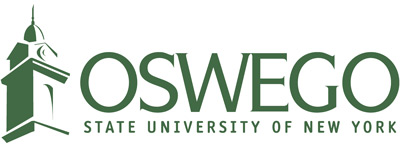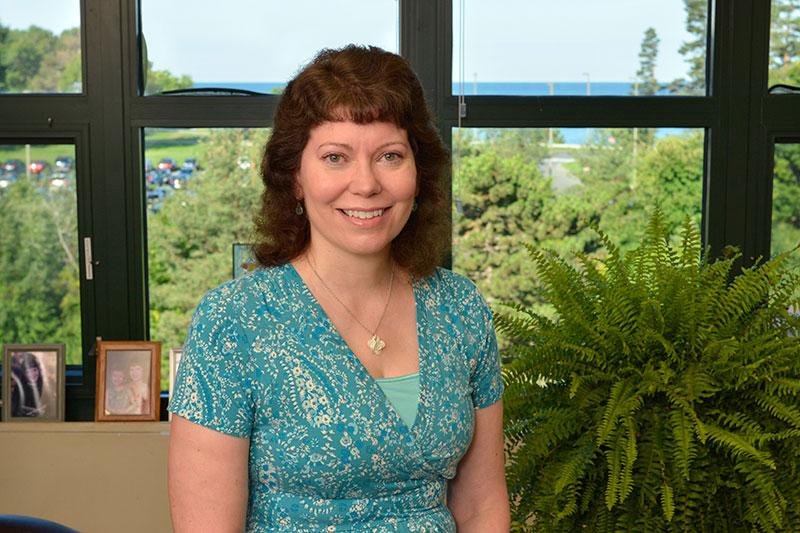Now human development chair, Brown 'fell in love with teaching'
In this issue’s Spotlight, meet human development professor and chair Laura Hess Brown, long involved in growing a multidisciplinary program that focuses on understanding—and improving opportunities for—people from infancy through old age.
Q. How long have you been at SUNY Oswego?
A. I came here as an undergraduate in psychology in 1980. So counting my undergraduate years and coming back first as an adjunct faculty member and then as a tenure-track faculty member, I have been here 32 years. I figured that out the other day—that was a little mind-blowing.
Q. Where were you during the intervening years?
A. I went for my master’s at Penn State in human development and family studies in 1984. Then I came back here to Central New York and got married. I worked for the Department of Social Services as a foster care caseworker for two years. I got a frantic call from (then-psychology chair) Bill Forrester, who had a lifespan class starting up in two weeks and the person who was supposed to teach it had bailed on him somehow. I wanted to give back to the department that had been so good to me. I thought, “Hey, let’s give it a try.” I absolutely fell in love with teaching. It became more and more clear to me that that was where I belonged.
Q. When did you join SUNY Oswego as a tenure-track professor?
A. After 10 years of teaching as an adjunct—I was everyone’s sabbatical replacement in the psychology department (Laughs.)—I did go back and get my doctorate at Syracuse University in child and family studies. While I was in grad school, the human development program was being developed. I had had conversations with (then-psychology professors) Cheryl Kaus and Rhonda Mandel about what I wanted to see included in the curriculum. When I insisted it was really important that students have a family-oriented course to take, I didn’t realize I was writing my own job description! When I graduated from SU in 1998, I already had this job in hand. That was a lovely coincidence.
Q. How does human development distinguish itself from psychology?
A. Human development is an interdisciplinary major. We cover the entire lifespan, and have cognates from sociology, anthropology, communications, counseling. We have a very applied focus. Students have to take two internships, because we really want students to have that field experience so they can connect the dots between what they learn in the classroom and what is actually happening in the human services field and social work. Many of our students go on to graduate school in counseling. We have built the program not only on what we think is important pedagogically, but on what employers—in schools and nursing homes, social services agencies—think is needed, as well.
Q. Where do your students intern?
A. Oswego County Opportunities is a big one. Salvation Army, local nursing homes, day care providers. We have connections with some of the family agencies, local schools—after-school programs, mentoring, job shadowing. Besides Oswego County, some sites are in Jefferson County, Onondaga County. I’ve had students from New Zealand doing international studies there. In 2011, we had approximately 85 majors. Right now, we’re knocking on the door of 300, plus 79 minors plus the gerontology minors. That’s a lot of students needing two internships.
Q. What are your specific areas of teaching interest?
A. I’m a lifespan developmentalist, so I can teach about any life stage. The course I developed from scratch was “Family Dynamics Across the Lifespan”—I always tell my students I raised it from a pup. I’ve taught child, adolescence, and I’m the gerontology minor coordinator, so I do the research methods course for that. I do the capstone and the internship course that goes with that. I’m starting my third year as chair.
Q. What is your favorite part of the job—your joy?
A. When a student is struggling with a concept and I have found a way to rephrase it so that now it makes sense—I love watching that light bulb go on and having the student get excited about learning something new. I really enjoy teaching the capstone, because I get to see them put all of those pieces together before they graduate. I have them for seven credit hours, including the associated internship. At the end of that experience they’re so ready, whether it’s for grad school or to go into the world of work. The sense of accomplishment they send back to me is very gratifying. I have a whole lot of hope for the future when I look at them.
Q. Do you have your own volunteer activities?
A. I do, and I think it’s important for our students to see that we walk the walk. I have been involved with SEFA (the State Employees Federated Appeal) for—oh, it’s got to be close to 20 years. I was a very early participant in the United Way Walk-a-Thon. I have done the Alzheimer’s Memory Walk for years and years, sometimes bringing students with me. I’ve given extra credit for community service activities for as long as I’ve taught. I was faculty adviser to Vega, the women’s junior-senior honor society on campus, for 10 years. They organize the United Way Walk-a-Thon. I really hated to step down from Vega, but I had really underestimated the amount of work as chair. I still do the Mahar bake-offs for SEFA. I have sung in my church choir for 27 years.
Q. What are some areas of research interest for you?
A. I have done research on the pedagogy of service learning, particularly in gerontology, with (emeritus professor of psychology) Paul Roodin. He and (human development faculty member) Dot Shedlock and I wrote an article that won a Peterson Award (article of the year) from the Association for Gerontology in Higher Education. Another area is people’s reactions to different forms of adoption. I’m an adoptive parent myself. Margaret Ryniker and I did that project a few years ago. My doctoral studies were in grandparent-grandchild relationships.
Q. What can you tell us about your family?
A. My husband and I have been married for 30 years. We have two children: Emily is 22, Diana is 15, both adopted. We are a bit unusual in that we have open adoptions with both our birth mothers. It’s very different. People don’t always understand how that works or how it’s possible. We were very, very fortunate. We were in the right place at the right time twice. At some point, I would really like to develop a course called “Adoption as a Family Form.”




